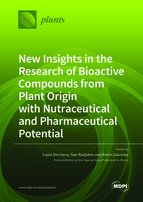New Insights in the Research of Bioactive Compounds from Plant Origin with Nutraceutical and Pharmaceutical Potential
A special issue of Plants (ISSN 2223-7747). This special issue belongs to the section "Phytochemistry".
Deadline for manuscript submissions: closed (20 June 2022) | Viewed by 51287
Special Issue Editors
Interests: metabolomics; natural product chemistry; bioactive compounds; GC-MS; LC-ESI-MS/MS
Special Issues, Collections and Topics in MDPI journals
Interests: natural products; bioactive compounds; GC-MS; LC-ESI-MS/MS; biotechnology
Special Issues, Collections and Topics in MDPI journals
Interests: phytochemical composition; antioxidant activity; metabolism and bioavailability of plant active substances
Special Issues, Collections and Topics in MDPI journals
Special Issue Information
Dear Colleagues,
Plant bioactive compounds are essential for human health owing to their multiple biological effects, such as antioxidant, anticarcinogenic, antiallergenic, anti-inflammatory, antimutagenic, and antimicrobial activities leading to beneficial effects on various noncommunicable diseases, such as autoimmune, inflammatory, cardiovascular, cancer, metabolic, and neurodegenerative diseases. Identifying these components and establishing their beneficial health effects are extremely active areas of scientific inquiry. The screening of natural sources for novel biologically active metabolites has been an essential part of several drug discovery programs.
This Special Issue aims to present recent developments in high-throughput and efficient analytical approaches enabling identification of plant-based compounds, the establishment of new protocols for evaluation of in vivo and in vitro bioactivities, and methods for extraction, isolation, and structural characterization of new bioactive components with nutraceutical and therapeutic potential.
Dr. Ivayla N. Dincheva
Dr. Ilian Badjakov
Prof. Bistra Galunska
Guest Editors
Manuscript Submission Information
Manuscripts should be submitted online at www.mdpi.com by registering and logging in to this website. Once you are registered, click here to go to the submission form. Manuscripts can be submitted until the deadline. All submissions that pass pre-check are peer-reviewed. Accepted papers will be published continuously in the journal (as soon as accepted) and will be listed together on the special issue website. Research articles, review articles as well as short communications are invited. For planned papers, a title and short abstract (about 100 words) can be sent to the Editorial Office for announcement on this website.
Submitted manuscripts should not have been published previously, nor be under consideration for publication elsewhere (except conference proceedings papers). All manuscripts are thoroughly refereed through a single-blind peer-review process. A guide for authors and other relevant information for submission of manuscripts is available on the Instructions for Authors page. Plants is an international peer-reviewed open access semimonthly journal published by MDPI.
Please visit the Instructions for Authors page before submitting a manuscript. The Article Processing Charge (APC) for publication in this open access journal is 2700 CHF (Swiss Francs). Submitted papers should be well formatted and use good English. Authors may use MDPI's English editing service prior to publication or during author revisions.
Keywords
- bioactive compounds
- extraction, isolation, and structural characterization
- herbal preparations and natural medicines
- benefits, analytical strategies for bioactive compound identification and quantification
- in vivo and in vitro bioactivity of botanicals









